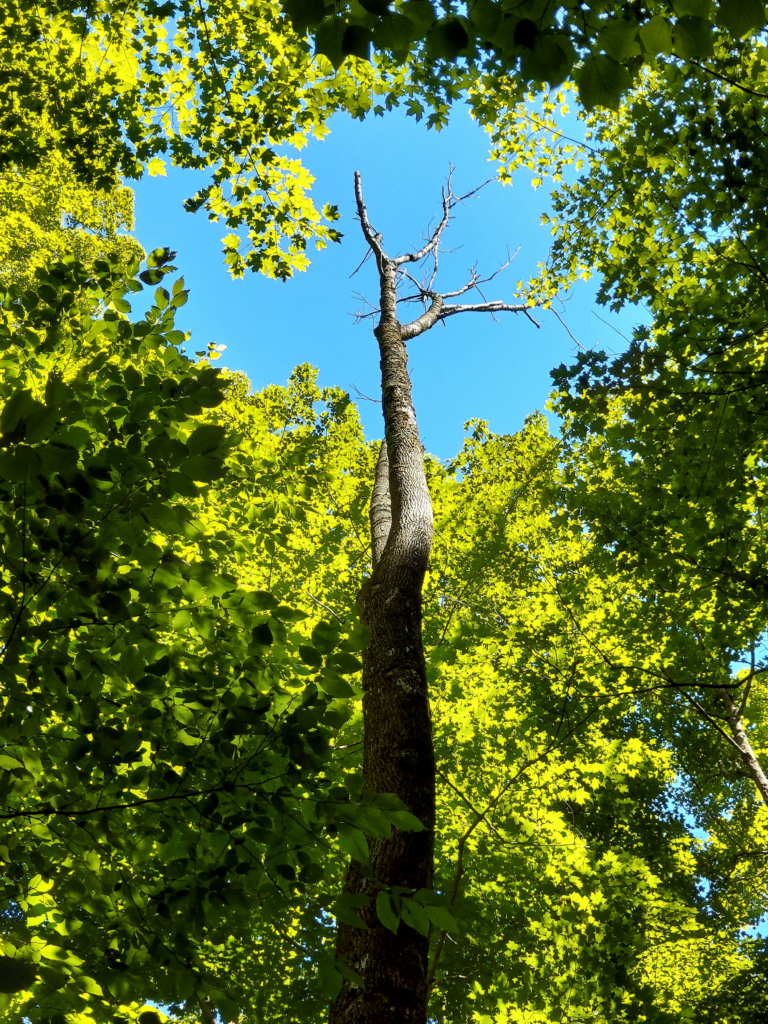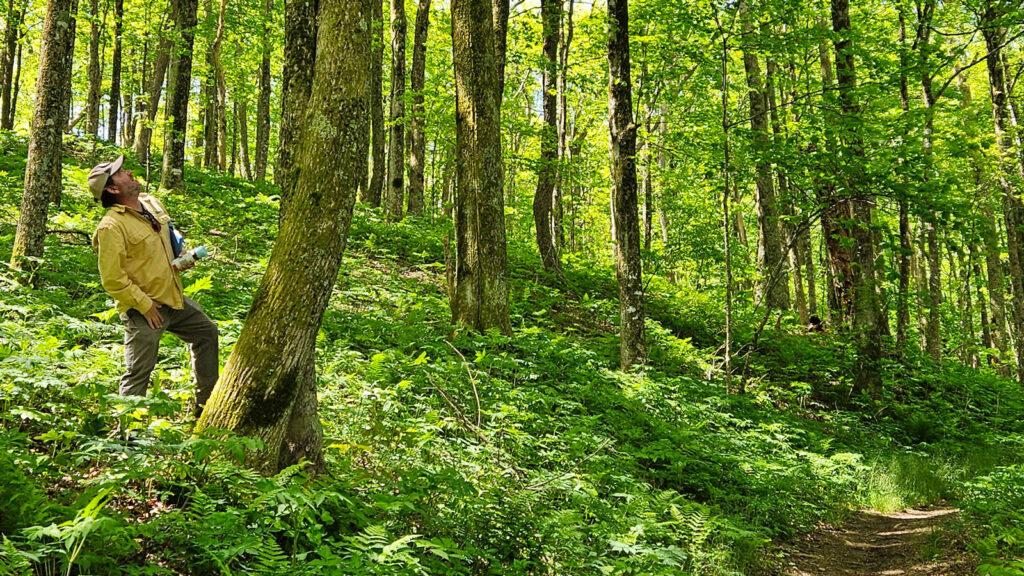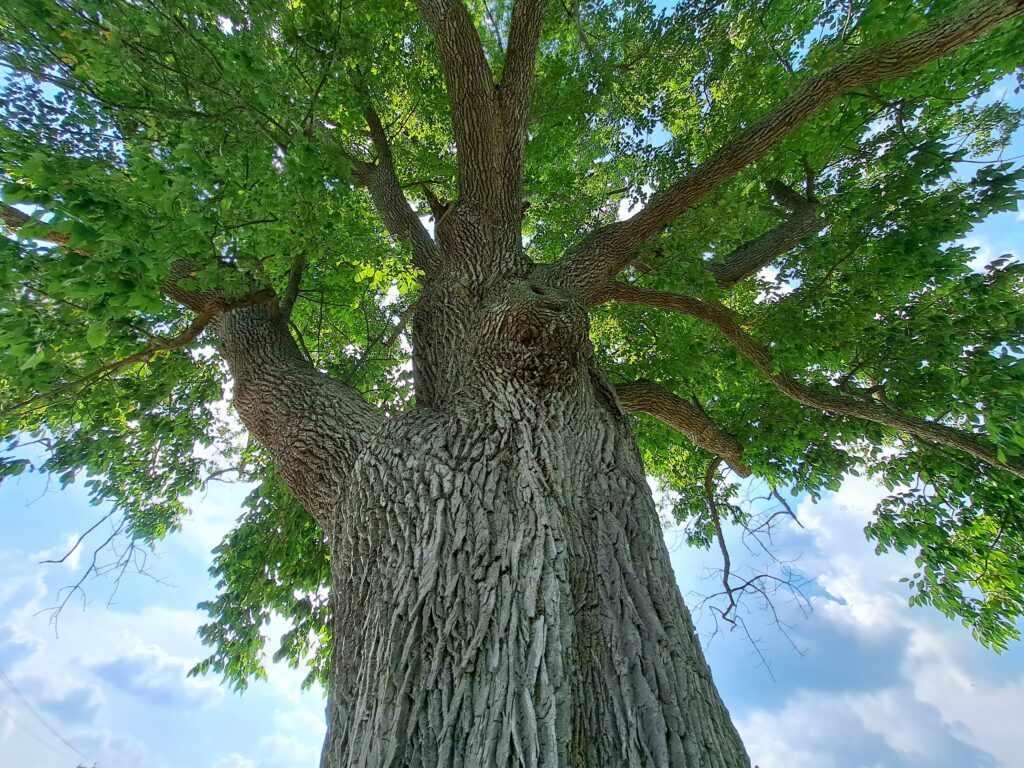Safeguarding the Appalachian Trail’s Ash Trees
August 8, 2024
Earlier this summer, Matt Drury, the Appalachian Trail Conservancy’s (ATC) Associate Director of Science and Stewardship, led a team to the Tennessee-North Carolina border. Equipped with specialized tools, the team set out to administer a preventative treatment that protects the Appalachian Trail’s ash trees from the deadly emerald ash borer, an invasive beetle that has devastated millions of ash trees across North America since its discovery in the U.S. in 2002. The trees treated on this trip are a part of the 1,398 ash trees along the Appalachian Trail that the ATC has been working to protect for nearly a decade.
The Threat of the Emerald Ash Borer
The emerald ash borer, a metallic green beetle from Asia, poses a severe threat to all species of ash trees in North America. While adult beetles harmlessly nibble on ash leaves, their larvae burrow into the tree’s bark and feed on its interior, disrupting the tree’s ability to transport water and nutrients. This internal damage, which can be challenging to detect in its early stages, ultimately strangles the tree from the top down, leading to its death within just a few years.

Photo by the ATC’s Natural Stewardship and Land Manager, Dan Hale, shows a gap in the canopy left by a dead ash tree.
The ATC’s efforts to conserve the A.T.’s ash trees began in 2016, when Matt Drury and MountainTrue biologist Josh Kelly noticed the impact of the emerald ash borer in North Carolina. They quickly devised a plan to protect mature ash trees along the A.T., hoping to preserve these trees for future generations, and with them, an iconic part of the Trail experience.
Treatment and Conservation Efforts
The ATC’s approach involves treating select ash trees with an insecticide to increase their chances of survival. Trees are carefully chosen based on their size, health, and proximity to the Trail. The treatment process involves boring small holes into the tree and injecting insecticide, which the tree then transports throughout its system. This treatment protects the tree from the emerald ash borer’s larvae for approximately three years.

Photo by the ATC’s Director of Communications, Ann Simonelli, shows Emily Powell administering emerald ash borer treatment.
As of now, ATC staff and partners from Georgia to Vermont have treated and monitored 1,389 ash trees along the Trail corridor, focusing on areas with high concentrations of ash trees, such as the A.T. in North Carolina and Tennessee. Other focus areas include the A.T. in Massachusetts, where some of the Trail’s most iconic and largest known ash trees are located, and Georgia where the team has treated the tallest ash tree in the state. These efforts have been remarkably successful, with 98% of treated trees surviving compared to the majority of untreated trees, which are dead or dying.

Photo by the ATC’s Director of Science and Stewardship, Marian Orlousky, shows the tags placed on an ash tree treated in 2016.
Protecting the Appalachian Trail Experience
Protecting ash trees means protecting the unparalleled A.T. experience that millions of Trail visitors have had the chance to enjoy over the last century. The Appalachian Trail has the power to change lives, give us respite from the modern world, and connect us back to nature. When ash trees are dead or dying along the A.T. landscape, it causes cascading ecological effects that diminish the A.T. experience and even present safety concerns for hikers.

Photo by the ATC’s Director of Communications, Ann Simonelli, shows Matt Drury inspecting an ash tree along the A.T. near the North Carolina-Tennessee border.
Ash trees directly support around 286 species of arthropods like insects and spiders, with 44 of these species relying exclusively on ash trees. The loss of ash trees can also lead to significant changes in canopy and community structure, altering the A.T. landscape’s biodiversity. Additionally, dead and dying ash trees pose safety risks to A.T. visitors, as they can become brittle and fall across the Trail or a campsite.
Expanding Ash Tree Protection
As the ash borer continues to decimate ash tree populations, the ATC is looking for opportunities to expand treatments and protect additional ash stands in more northern Trail states. In 2023, the ATC’s Natural Resources and Stewardship Manager, Dan Hale, worked with US Forest Staff to treat 212 new ash trees across six stands in Vermont.
Despite the success of these efforts, the long-term outcomes remain uncertain. Factors such as climate change, other nonnative invasive species, and human activities could influence the positive results the treatment program has yielded so far. Additionally, the cost of treating a single tree, around $150 for the insecticide alone, poses financial challenges.
We’re grateful to the National Fish and Wildlife Foundation for providing grant funding that enabled a majority of these ash tree treatments in 2023 and 2024. This work is a core pillar of the ATC’s broader efforts to monitor and mitigate the damage caused by non-native invasive species on the Trail in Georgia, North Carolina, Tennessee, and Virginia. This grant funding will run out in 2025, and the ATC relies on our supporters to be able to continue protecting the Trail experience from the damaging effects of non-native invasive species.

Photo by the Marian Orlousky, the ATC’s Director of Science and Stewardship shows one of the A.T.’s largest treated ash trees in Massachusetts.
Support Our Work
The ATC’s ash tree treatment program is a critical conservation effort aimed at preserving the ecological integrity of the Appalachian Trail. By protecting ash trees from the emerald ash borer, the ATC is helping to safeguard the Trail’s biodiversity and prioritize the experience and safety of hikers. As Matt Drury aptly puts it, “What’s the value of a National Scenic Trail that traverses a compromised landscape?” Through our team’s dedicated work alongside our partners, the ATC is striving to maintain the beauty and ecological richness of the A.T. for future generations.
Join us in our mission to protect the Appalachian Trail’s natural heritage. Together, we can help ensure that this iconic Trail remains a vibrant and thriving ecosystem for all to enjoy.
